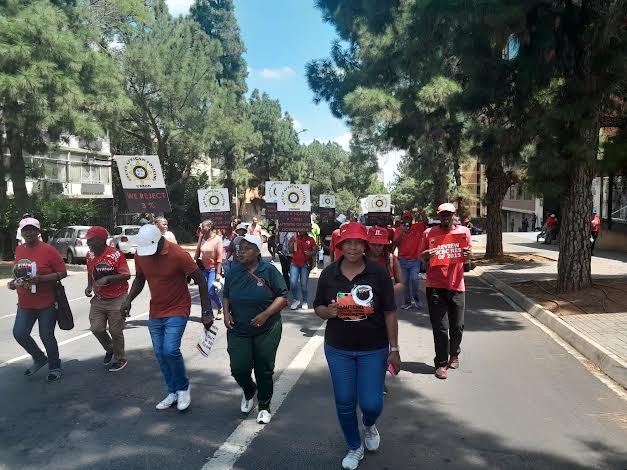
9 March 2023
Striking NEHAWU members protested in the streets of Tshwane. Photo: Chris Gilili
Here is information on the ongoing public sector strikes – who is striking, and what is at stake.
National Education Health Workers’ Union (NEHAWU) had
Police and Prisons Civil Rights Union (POPCRU) had
South African Police Union (SAPU) had 82,000 members at the end of 2021 according to PSCBC figures.
Democratic Nursing Organisation of SA (DENOSA) had 69,000 members according to PHSDSBC figures from end-2021 (matching the figures from the PSCBC).
South African Emergency Personnel’s Union (SAEPU) had 2,000 members according to PHSDSBC figures from end-2021 (matching the figures from the PSCBC).
Public and Allied Workers Union of South Africa (PAWUSA) had
South African Medical Association Trade Union (SAMATU) had 5,000 members at the end of 2021 according to the PSCBC.
National Union of Public Service and Allied Workers Union (NUPSAW) had:
The PSCBC records a total of 1.2-million public service union members in their bargaining council structure at the end of 2021.
SADTU claims 260,000 members, which matches figures from the PSCBC at the end of 2021.
NAPTOSA had 44,000 members at the end of 2021 according to PSCBC figures.
HOSPERSA had 57,000 members at the end of 2021 according to PSCBC figures.
Public Servants Association of South Africa (PSA) claims more than 235,000 public-sector employees, and 218,000 members are recorded by the PSCBC.
One publication wrote: “The department proposes a salary increase of 4.7%, and the union [NEHAWU] is demanding 10-12%.”
This is incorrect. NEHAWU’s demands relate to the 2022 wage increase, which was 3%, and unilaterally implemented by the government. The unions demand 10%, among other things 3% on top of the rate of inflation, which is 7%.
The 4.7% increase relates to 2023, and has no bearing on NEHAWU’s demands for 2022. In fact, NEHAWU, and the other unions that maintain a dispute regarding 2022, are not entering into discussions about the 2023 wage bill until the previous dispute is settled.
Other unions, like the PSA, are engaging the government on their wage demands for 2023/24. However, even here, there has been confusion.
While it has been reported that the PSA “agreed” to the 3% deal, according to a 16 February press statement, the PSA “strongly condemned the unilateral implementation of a 3% salary increase” for 2022/23 (the focus of the current strike action), but have consigned this as a settled matter, concluding that the loss of income from strike action would not offset possible gains by a new settlement.
In a 21 December statement, the PSA clarified that the union had not accepted the 3% wage offer, but rather that the government had “unilaterally implemented the 3% wage offer whilst the PSA was in the midst of industrial action”.
The PSA warned their fellow public sector union that “failure to commence with 2023/24 salary negotiations without delay will disadvantage public servants”, but said that it “respects other unions’ position” to not engage.
The common refrain that South Africa’s public service is “bloated” does not withstand scrutiny.
In 1995, there were 1,269,000 public servants for a population of 44 million (2.9%). Today, there are 1,164,000 for about 61-million people (1.9%). Salaries for school teachers (33%), healthcare workers (23%) and police (12%) are the largest employment costs for the government.
The available data on public school overcrowding, healthcare worker shortages, and understaffed police stations, across the country, does not support the claim that we have too many teachers or nurses.
According to a written reply to a parliamentary question, there were 164,661 vacant posts in the public sector. A large share of these vacancies are in the healthcare sector. In 2022 there were 26,444 vacant posts, in the public health sector hospitals alone. According to the latest Department of Health annual report, for 2021/22, the department underspent its allocation for employee compensation by R44-million due to its failure to fill vacancies.
In the latest budget review, figures from the National Treasury show that government expenditure on employees as a share of total government expenditure has been steadily decreasing over the last decade, from 36% in 2013/14, to 32% for 2022/23. Meanwhile, government spending on interest has ballooned from 10% to 15% in the same period.